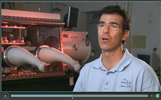


Vincent Battaglia, with Berkeley Lab’s Environmental Energy Technologies Division, was recently featured on KQED’s QUEST program discussing battery technology. In the show, host Spencer Michaels questions why electric cars are so far from being commercially viable and Battaglia explains how involved and expensive it is to create lithium ion batteries and what his research group at the Lab is doing to increase the capacity, bring down the cost and increase the speed of production of batteries. ![]()
 People: New Deputy Operating Officer Hired
People: New Deputy Operating Officer Hired Anita Gursahani has been named the new Deputy Chief Operating Officer, replacing Sandy Merola, who left the Lab earlier this year. Gursahani will work with Chief Operating Officer Jim Krupnick to help continue improvements to the Operations Division and its support of the Lab’s scientific mission. This includes identifying the appropriate level of services for employees, increasing meaningful communication, and ensuring that work at the Lab is performed safely. Previously Gursahani was the Deputy Associate Director for Facilities & Infrastructure at Livermore Lab. She has a B.S. in electrical engineering from Cal Poly and an MBA from Saint Mary’s College. When not working or spending time with her family, Gursahani enjoys running and participates in local races.
 [Greentechmedia] How much energy do we waste in America? A little over half of it, says Arun Majumdar, division director of Berkeley Lab’s Environmental Energy Division. The U.S. consumes about 100 quads of energy a year, he said. A quad is a quadrillion BTUs. "Of the 100 quads, about 55 to 60 go into waste heat," he said. A new crop of startups, however, are tinkering with ways to make this useful, including Majumdar’s development of thermoelectric materials. More>
[Greentechmedia] How much energy do we waste in America? A little over half of it, says Arun Majumdar, division director of Berkeley Lab’s Environmental Energy Division. The U.S. consumes about 100 quads of energy a year, he said. A quad is a quadrillion BTUs. "Of the 100 quads, about 55 to 60 go into waste heat," he said. A new crop of startups, however, are tinkering with ways to make this useful, including Majumdar’s development of thermoelectric materials. More>
 In The News: Microscopic Bio-Robot Slaves
In The News: Microscopic Bio-Robot Slaves[New Scientist] Shrinking robots allows them to carry out ever more delicate tasks. But even the smallest built so far are too big to be able to, say, imprint microscopic, or even nanoscale, patterns onto microchips. Now a team led by Jan Liphardt, with Berkeley Lab’s Physical Biosciences Division, says it may be possible to create new species of slave bacteria to do the job instead. Thousands of such "biobots" - or minicells - could carve out the kind of microscopic features needed on microprocessors, or gene chips used to test for millions of specific DNA sequences at once. More>
 Special Event: Van Jones Talk Tomorrow on ‘The Green Collar Economy’
Special Event: Van Jones Talk Tomorrow on ‘The Green Collar Economy’ The Berkeley Energy and Resources Collaborative, of which Berkeley Lab is a member, is sponsoring a talk by Van Jones tomorrow at 6 p.m. at International House on campus. Jones will discuss his new book, “The Green Collar Economy,” which explores how “a green economy that rescues the polar bears can also rescue the U.S. economy — putting America back to work; driving down energy and food prices; giving green-collar jobs and a second chance to wayward youth; and ending forever the need for oil wars and resource wars.”
From a new employee orientation to a stress relief workshop and an investment strategy clinic, the HR Benefits department hosts a number of events to help staff manage their work and life. To help employees track upcoming events, the department is producing a calendar, and the December edition is now available.